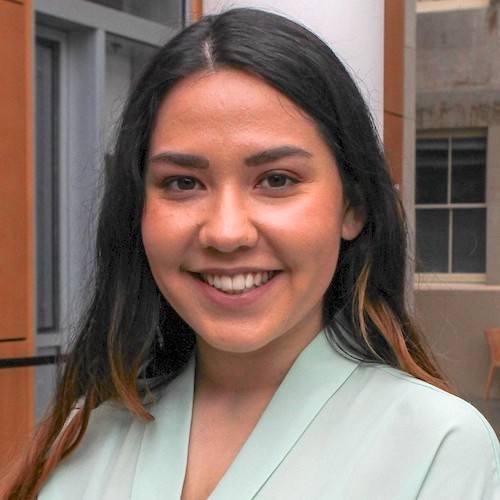Madeline Parga(she/hers)
My research interests lie within the vast potential of transdisciplinary investigation into applications of artificial intelligence (AI) for smart environments. This was largely inspired by increasing collaboration in the field between occupational scientists and engineers, as well as between occupational scientists and disability studies scholars through the OT+DS network. Due to the strengthening of these connections, I believe it is not only largely possible but responsible to draw upon this network of researchers to consider how smart technology applications will influence both social and physical factors of accessibility.
As an occupational scientist, I hope to apply the biopsychosocial model to investigations of how smart devices in occupational environments will impact all people, while emphasizing disability as an identity and not only a condition of the being as it has largely been treated by literature investigating AI applications. I am also interested in the design process and how it dis/allows accessibility within the smart environments already utilized today.
Education
Bachelor of Science (BS)
in Biology & Society
2021 | Cornell University
Selected Publications
Parga, M. R., Roll, S. C., Lucas, G. M., Becerik-Gerber, B., & Naranayan, S. (2024). Differences in self-rated worker outcomes across stress states: An interim analysis of hybrid worker data. Proceedings of the Human Factors and Ergonomics Society Annual Meeting, 68(1), 1404–1409. https://doi.org/10.1177/10711813241275500 Show abstract
Stress experiences can have dire consequences for worker performance and well-being, and the social environment of the workplace is a key contributor to worker experience. This study investigated the relationship between hybrid workers’ self-ratings of productivity, mood, and stress with perceptions of positive (eustress) and negative (distress) stress states. We hypothesized that self-ratings would vary across combinations of eustress and distress experiences and that these differences would differ based on the social context. Ecological momentary assessments (EMA) were used to obtain ecologically valid data at four data points each workday across a 4-month study period in a cohort of seven office workers. Findings aligned with the Yerkes–Dodson law, such that higher states of arousal were associated with greater self-perceived productivity, and higher stress magnitudes were found when distress existed. Compared to other states, eustress was associated with higher productivity in work-related activities and better mood across all activity types.
Parga, M. R., Evans, K. D., Sommerich, C. M., & Roll, S. C. (2024). Sonographers and vascular technologists offer potential solutions to promote the health and well-being of their workforce. Journal of Diagnostic Medical Sonography, 40(2), 127-139. https://doi.org/10.1177/87564793231217217 Show abstract
Objective. Work-related injuries have a major effect on worker health and well-being. This is particularly true in sonography, where work-related musculoskeletal disorders (WRMSDs) are common. In response to the current challenge of understanding strategy implementation across social and organizational dimensions, this research captured sonographers’, echocardiographers’, and vascular technologists’ perceptions of critical administrative, organizational, and general health and training challenges, and potential solutions for improving worker health and well-being.
Materials and Methods. A survey invitation was sent to the WRMSD Grand Challenge longitudinal study registry participants. Open-ended questions on the online questionnaire allowed respondents to share comments, ideas, or potential solutions to improve worker health and well-being regarding the administrative and organizational environment or through training and general health interventions. There were 377 free-text responses that were qualitatively analyzed using a grounded theory approach to generate overarching themes and identify emerging theory, supported by initial coding, focused coding, and reflexive memoing. A member check was conducted by interviewing four participants to refine and confirm the findings.
Results. Five themes were identified: “Limits and Guidelines,” “Injury Education,” “Ergonomics Training Constraints,” “Resources and Equipment,” and “Individual Habits.” Participant suggestions within these themes were categorized and mapped onto a sociotechnical systems model that was developed previously to study the healthcare system(s) in which sonography users work. This conceptual mapping revealed how these solutions were situated to impact different levels of the work environment. The themes and mapping supported an emerging grounded theory: Risk Reduction Relies on Proper Employee Representation.
Conclusion. These qualitative findings align with contemporary guidelines and recommendations for mitigating injuries in sonographers, illuminating challenges and solutions targeting levels of influence beyond the staff sonographers’ scope. The need for representation of sonographers at higher-level administrative levels has not heretofore been addressed by WRMSD guidelines.
⋯






